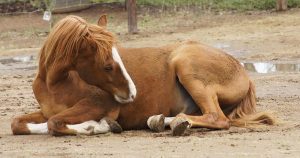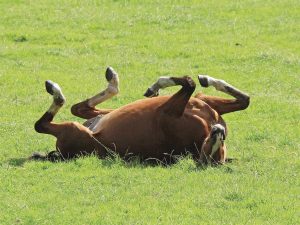77 To Fart or Not to Fart
banks177; park3018; and muel0905
An investigation of gas colic in horses, how to help and prevent this from happening.
Student learning Objectives
- Correctly display the gastrointestinal system of the horse.
- Demonstrate how gas colic can occur in horses.
- Explain what contributes to gas colic in horses and why.
- Recognize the signs of colic and how we would diagnose it.
- Recognize how treatment will help relieve gas colic.
Lesson
Colic is a general term for abdominal pain in horses. It can have many causes but most often, horses showing signs of colic have “gas” colic. This means large amounts of gas have built up in the gastrointestinal tract and the intestine begins to spasm, or squeeze down, around that gas. Think of it like stomach cramps; they can be fairly uncomfortable but are easily treated. The following lesson and activities will help you to better understand how and what is happening in a horses body during gas colic and what veterinarians and horse owners can do to treat gas colic.
To start, watch this video to familiarize yourself with the horse GI system:
Balloon Activity
Watch and try this experiment out to see what gas is like in a horses’ stomach. In this experiment, the baking soda is the happy microbes in the horse’s cecum and colon, and then vinegar is a sudden change in food or food that is easily fermentable.
After your balloon is filled with gas, pinch the balloon opening while keeping it on a bottle. Try and tie a know in the ballon, and don’t let the gas out once materials are combined. Observe what happens!
What would happen if you removed the knot? How can this activity be translated to what happens in horses?
What Causes Gas Colic?
Gas colic in horses is caused by changes in feed or an impaction that prevents the normal passing of gas through the gastrointestinal tract. Exposure to easily fermentable grasses or hay, such as grazing on pastures with high clover content or lush growth may cause gas colic. The only way gas can be passed through the intestinal tract is by farting because horses are unable to burp. The valve between the stomach and esophagus only allows one-way flow.


Signs of Colic
Signs of colic can vary drastically, depending on the level of pain and the attitude of the horse. With mild abdominal discomfort, horses may have less of an appetite or be more depressed than usual. Horses may repeatedly lie down or roll on the ground. More specific behaviors would then involve looking at or biting at the belly, stretching as if to urinate, and intermittent pawing.
So…How Do We Fix It?
Gas colic can cause lots of cramping, so sometimes it is helpful to give medication that decreases the squeezing of the gas in the gut. Pain medications are also given because this can be uncomfortable for the horse! A tube can be placed in the mouth and reach all the way into the stomach to give warm water with electrolytes (kind of like Gatorade) or mineral oil to reduce some of the gas and may treat constipation. Exercise can help increase movement of things through the gastrointestinal tract so it is also recommended to exercise the horse regularly.
You completed the lesson! Time to check your understanding.

